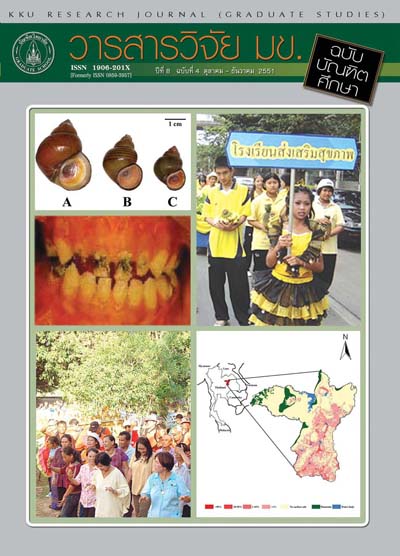Effects of Surface Salt on Distribution and Density of Snails in Family Viviparidae in Khon Kaen Province, Thailand, Analyses by Using Geographic Information System
Keywords:
Viviparid snail(หอยวงศ์หอยขม), Surface salt(เกลือผิวดิน), Geographic information system (GIS)(ระบบสารสนเทศภูมิศาสตร์)Abstract
Effects of surface salt on distribution of snails in family Viviparidae in Khon Kaen province, northeast Thailand were analyzed the association model by using geographic information system. Mollusks were collected in twenty localities base on various levels of surface salt, 16 – 20 stations/reservoir. Three species of viviparid snails were found in 9 out of 20 reservoirs, i.e. Filopaludina (Siamopaludina) martensi martensi, F. (Filopaludina) sumatrensis speciosa and Idiopoma umbilicata. Nine families (11 species) of sympatric mollusks shared the same habitat with viviparid snails. Water quality in the viviparid habitat revealed that, pH: 6.79 - 8.01, temperature: 23.06- 27.33 oC, turbidity: 3.26 – 163.00 NTU, conductivity: 0.42 - 10.25 mS/cm, salinity: 0.20 - 5.69 ppk and dissolved oxygen (DO): 0.43 – 6.01 mg/L. Dominant planktons in food content from digestive tracts of F. (S.) martensi martensi consisted of diatoms and they were the same type to Bithynia siamensis goniomphalos, first intermediate host of human liver fluke, Opisthorchis viverrini. That is viviparid snails may play important role in food competition with B. siamensis goniomphalos. The number of B. siamensis goniomphalos was negative correlation to the number of F. (S.) martensi martensi (r = - 0.182, p < 0.05). Only one type of Virgulate xiphidiocercariae was found in F. (S.) martensi martensi by using electric light, daytime cercarial shedding. Density of F. (S.) martensi martensi population was negative correlation to salinity (r = - 0.289, p < 0.01). Geographic information system analysis showed considerably high distribution of F. (S.) martensi martensi in the area with surface salt >0 - 50% of surface areas revealed that the index of 0.079, 0.027, 0.001 and 0, respectively. The geographic information system analysis model was assessed and approved by mollusk survey.
ผลของเกลือผิวดินต่อการกระจายและความหนาแน่นของหอยในวงViviparidaeในจังหวัดขอนแก่น ประเทศไทย โดยวิเคราะห์ข้อมูลด้วยระบบสารสนเทศภูมิศาสตร์ ศึกษาโดยเก็บตัวอย่างหอยในแหล่งน้ำที่มีสภาพเกลือผิวดินที่ระดับแตกต่างกัน ทั้งหมด 20 แหล่งน้ำ ทำการสุ่มเก็บตัวอย่างในแต่ละแหล่งน้ำ 16-20 สถานี พบหอยในวงศ์ Viviparidae 3 ชนิดคือFilopaludina (Siamopaludina) martensi martensi, F. (Filopaludina)sumatrensis speciosa และ Idiopoma umbilicataในแหล่งน้ำที่9 แหล่งจากจำนวนที่ทำการเก็บตัวอย่าง20 แหล่งพบหอยร่วมนิเวศ 9 วงศ์ (จำนวน 11 ชนิด)ลักษณะทางภายภาพน้ำที่พบหอยวงศ์ Viviparidae มี pH 6.79 -8.01 อุณหภูมิ 23.06- 27.33 องศา,ค่าความขุ่น 3.26 - 163.00 NTU,ค่าการนำไฟฟ้า 0.42 - 10.25 mS/cm,ค่าความเค็ม 0.20 - 5.69 ค่าการละลายของออกซิเจน (DO) 0.43 - 6.01 mg/L. ในระบบทางเดินอาหารของหอย F. (S.) martensi martensi ที่เป็นประชากรส่วนใหญ่ในการศึกษาครั้งนี้ พบชนิดของแพลงก์ตอนเหมือนกันกับBithynia siamensis goniomphalos ซึ่งเป็นโฮสต์กลางของพยาธิใบไม้ตับของคนชนิดOpisthorchis viverrini จึงน่าจะเป็นสัตว์ที่แก่งแย่งอาหารกัน ซึ่งพบว่าจำนวนหอย B. siamensis goniomphalos มีความสัมพันธ์เชิงลบกับหอย martensi martensi (r = - 0.182, p < 0.05) จากการสำรวจพบการติดเชื้อVirgulate xiphidiocercariae ในหอย F. (S.) martensi martensi เพียงชนิดเดียวจากวิธีการcercarial shedding โดยใช้แสงกระตุ้นตอนกลางวัน ความหนาแน่นของหอย F. (S.) martensi martensi มีความสัมพันธ์เชิงลบต่อระดับความเค็มของแหล่งน้ำ (r = - 0.289, p < 0.01) การวิเคราะห์ความหนาแน่นด้วยข้อมูลสารสนเทศภูมิศาสตร์ พบความหนาแน่นของF. (S.) martensi martensi สูง ในพื้นที่เกลือผิวดิน>0 - <1% ของพื้นที่ผิว(ค่าดัชนี =.893)เปรียบเทียบกับพื้นที่เกลือผิวดินอื่นๆและพบความหนาแน่นต่ำในพื้นที่เกลือผิวดินที่ระดับ0, 1 - 10, 10 - 50 และ >50% ของพื้นที่ผิวดินโดยมี ค่าดัชนีเท่ากับ .079,0.027, 0.001และ 0 ตมลำดับ ค่าดัชนีได้ทำการประเมินความถูกต้องโดยการสำรวจในพื้นที่ ที่ได้ทำการวิเคราะห์แล้วได้ค่าที่ถูกต้อง



